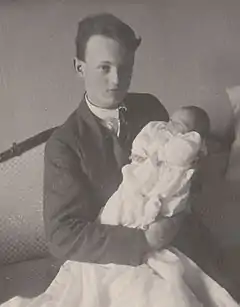Albrecht, Duke of Bavaria
Albrecht, Duke of Bavaria (Albrecht Luitpold Ferdinand Michael; 3 May 1905 – 8 July 1996[1]) was the son of the last crown prince of Bavaria, Rupprecht, and his first wife, Duchess Marie Gabrielle in Bavaria. He was the only child from that marriage that reached adulthood. His paternal grandfather was Ludwig III of Bavaria, the last king of Bavaria, who was deposed in 1918.
| Albrecht | |||||
|---|---|---|---|---|---|
| Duke of Bavaria | |||||
.jpg.webp) Albrecht in 1948 | |||||
| Head of the House of Wittelsbach | |||||
| Tenure | 2 August 1955 – 8 July 1996 | ||||
| Predecessor | Rupprecht | ||||
| Successor | Franz | ||||
| Born | 3 May 1905 Munich, Kingdom of Bavaria, German Empire | ||||
| Died | 8 July 1996 (aged 91) Berg Castle, Starnberg, Bavaria, Germany | ||||
| Burial | Wittelsbach cemetery, Andechs Abbey, Bavaria | ||||
| Spouse | Countess Maria Draskovich de Trakostjan
(m. 1930; died 1969)Countess Marie-Jenke Keglevich de Buzin
(m. 1971; died 1983) | ||||
| Issue |
| ||||
| |||||
| House | Wittelsbach | ||||
| Father | Rupprecht, Crown Prince of Bavaria | ||||
| Mother | Duchess Marie Gabrielle in Bavaria | ||||
Life

Following the First World War, Albrecht's grandfather King Ludwig was deposed. Albrecht and the family temporarily moved from Bavaria to the Austrian Tyrol.[1]
His family, the House of Wittelsbach, were opposed to the regime of Nazi Germany and refused to join the Nazi Party. His father, the former Crown Prince Rupprecht, earned Hitler's enmity by opposing the Beer Hall Putsch in 1923. In 1933, shortly after Adolf Hitler's rise to power, he sent his son Albrecht to President Paul von Hindenburg with a protest letter strongly objecting to the appointment of governors at the head of the federal states and thus the de facto abolition of German federalism. This public opposition meant that Prince Albrecht, who had studied forestry, was prevented from completing his studies.[1] In July 1934, Albrecht emigrated to Hungary with his family. From 1935 to 1939 the family returned to Bavaria and lived in seclusion in Kreuth, but his father emigrated to Italy in 1939 and Albrecht and his family moved back to Budapest, where they stayed in a rented apartment in the Castle Quarter. They often visited his wife's Hungarian and Croatian relatives in the countryside, as well as Albrecht's uncle Prince Franz of Bavaria at his Nádasdy Castle in Sárvár. The children received private lessons. Albrecht took over the management of court hunting for the Prince Regent Paul of Yugoslavia until 1941.[2]
In September 1943, the German Army occupied Italy and the former crown prince went into hiding in Florence. In October 1944, after Germany had occupied Hungary in March, Albrecht and his family were arrested by the Gestapo in the Erdődy mansion in Doba, Hungary, and deported to the Sachsenhausen concentration camp.[1] Together with his wife, his four children and three of his half-sisters, they were held captive as “special prisoners” and then transported to the Flossenbürg and Dachau concentration camps. Albrecht almost died of dysentery. Badly hit by hunger and disease, the family barely survived. His son Franz writes in his memoirs that they only received one slice of bread, often moldy, per person per day as food. Despite the dramatic situation, according to him, his parents behaved “completely confidently from the start”. “My father used his aggressiveness as his only weapon and attacked anyone who came too close to him.”[3]
Towards the end of the war, they were interned with other special prisoners, including the family of General Paulus, in a former hotel on Lake Plansee (Tyrol), but had to remain there under military guard even after they were liberated by the United States Third Army. After a while, Albrecht and his family fled to Linderhof and hid there with a forest ranger. Finally, together with numerous refugees from Hungary, they moved into an outbuilding of Leutstetten Castle near Starnberg, which was occupied by an Allied commission, where after some time the former crown prince also returned from Rome.[4]
Since 1949 Albrecht lived at Berg Palace (Bavaria), 20 kilometres (12 mi) southwest of Munich on Lake Starnberg, in relative seclusion until the end of his life. His son Franz remembers: “He came back after being away for many years, having previously experienced a decade of severe disappointments - including on a human level. He came back to a country where almost all of his real friends had been murdered or fallen. And he had mostly bad memories of some of the people who had survived and whom he met back then... For him, many places were contaminated by the Nazi era. He came back to a Bavaria that was no longer his Bavaria. The resulting isolation accompanied him throughout his life.”[5]
Albrecht became head of the deposed royal family of Bavaria with the death of his father on 2 August 1955. As head of the House of Wittelsbach, Albrecht was also Grand Master of the Wittelsbach House Orders, the Order of Saint George, the Order of St. Hubert and the Order of Theresa. On Christmas Eve 1952, Albrecht of Bavaria was invested in the Knights' Order of the Holy Sepulchre in Jerusalem; he was president of its Bavarian Order Province.
The Duke appeared in public on important occasions. In order to remain present, he established the annual receptions by the head of the House of Wittelsbach at Nymphenburg Palace, which are still held today, to which around 1,500 guests from state politics, municipalities, churches and sciences, art and medicine as well as friends and relatives are invited.[6]
In 1959 Albrecht, in an official ceremony, returned the Greek crown jewels (originally made for a Bavarian prince who reigned as Greece's first modern monarch, King Otto) to the Greek nation, accepted by King Paul of Greece. Together with his son Franz and a daughter, he had taken part in the ship tours organized by King Paul of Greece and Queen Frederica in 1954 and 1956, which became known as the “Cruises of the Kings” and were attended by over 100 royals from all over Europe.[7]
In 1980 Albrecht presided over sumptuous ceremonies in Bavaria celebrating the 800th anniversary of the ascension of the House of Wittelsbach to the Bavarian throne.[8]
Albrecht was a prolific hunter and deer researcher, collecting 3,425 sets of antlers, now partially shown in a permanent exhibition on his research activities in the former royal castle at Berchtesgaden. He also wrote two books on "the habits of deer"[1] for which he (and his second wife) received honorary doctorates by the biological faculty of the Ludwig Maximilian University of Munich. While visiting Brazil in 1953, where he acquired a facenda in the rainforest, he encountered Brazilian Mastiffs and took some to Germany, introducing the dog breed to Europe.
Albrecht died on 8 July 1996, aged 91, at Berg Palace. His funeral at Theatine Church, Munich was conducted by Friedrich Wetter, the Archbishop of Munich.[1] He was buried on a family graveyard he himself had installed in 1977 at Andechs Abbey.
Jacobite succession
As the eldest son of the eldest son of Archduchess Maria Theresa of Austria-Este (1849–1919), recognized by Jacobites as "Queen Mary IV (of England) and III (of Scotland)",[9] he was also the dynastic representative and heir-general of England, Scotland and Ireland's last Stuart king, James II and VII, deposed in 1688.[10]
Marriages and children
Albrecht married Countess Maria Draskovich of Trakostjan (8 March 1904 in Vienna – 10 June 1969 in Wildbad Kreuth) on 3 September 1930 in Berchtesgaden.[11] Daughter of Count Dionys Maria Draskovich von Trakostjan and Princess Juliana Rose von Montenuovo (a great-granddaughter of Marie-Louise of Austria, sometime Empress of the French), she belonged to a family of the Croatian nobility known since 1230 and made Imperial counts in 1631.[12] Although Albrecht's father allowed the wedding, a Wittelsbach family council concluded that the marriage was non-compliant with the dynasty's marital tradition as set out in its historical house laws,[12] and the names of the couple's four children were excluded from the Almanach de Gotha.[11] In 1948, however, a juridical consultation advised that the head of the house has sole authority to determine the validity of marriages within the House of Wittelsbach, prompting Crown Prince Rupprecht to recognize Albrecht's marriage as dynastic on 18 May 1949.[8][12]
On 21 April 1971 in Weichselboden, Albrecht married Countess Marie-Jenke Keglevich of Buzin (23 April 1921 in Budapest – 5 October 1983 in Weichselboden), daughter of Count Stephan Keglevich de Buzin and Countess Klára Zichy of Zich and Vásonkeö. They had no children.[12]
At the time of his death, Albrecht had four children from his first marriage, fifteen grandchildren and twenty-six great-grandchildren. His children are:
- Princess Marie Gabrielle (b. 1931), married 1957 Georg, Prince von Waldburg zu Zeil und Trauchburg (1928-2015)
- Princess Marie Charlotte (1931-2018), married 1955 Paul, Prince von Quadt[13] zu Wykradt und Isny (1930-2011)
- Franz, Duke of Bavaria (b. 1933)
- Prince Max, Duke in Bavaria (b. 1937), married 1967 Countess Elisabeth Douglas (b. 1940), great-granddaughter of Philipp, Prince of Eulenburg
Honours and styles
Titles and styles
Albrecht was styled Prinz von Bayern (Prince of Bavaria) at birth.[14] After the death of his father in 1955 he changed his style to Herzog von Bayern (Duke of Bavaria).[15]
As head of the House of Wittelsbach, Albrecht was traditionally styled as His Royal Highness the Duke of Bavaria, of Franconia and in Swabia,[16] Count Palatine of the Rhine.[17]
Dynastic honours
 Württemberg Royal Family: Knight Grand Cross of the Royal Order of the Crown, Special Class
Württemberg Royal Family: Knight Grand Cross of the Royal Order of the Crown, Special Class.svg.png.webp) Austro-Hungarian Imperial and Royal Family: Knight of the Order of the Golden Fleece, 1953[18]
Austro-Hungarian Imperial and Royal Family: Knight of the Order of the Golden Fleece, 1953[18]
Foreign honours
.svg.png.webp) Vatican: Knight Grand Cross with Collar of the Order of the Holy Sepulchre[19]
Vatican: Knight Grand Cross with Collar of the Order of the Holy Sepulchre[19] Liechtenstein: Knight Grand Cross of the Order of Merit of the Principality of Liechtenstein, Grand Star
Liechtenstein: Knight Grand Cross of the Order of Merit of the Principality of Liechtenstein, Grand Star
Ancestry
References
- Cowell, Alan (11 July 1996). "Duke Albrecht Is Dead at 91; Pretender to Bavarian Throne". New York Times. Retrieved 30 November 2013.
- Franz von Bayern (Francis of Bavaria), with Marita Krauss: Zuschauer in der ersten Reihe: Erinnerungen (Front row audience: memories), publisher C. H. Beck, 2023, p. 5
- Francis of Bavaria (with Marita Krauss): Zuschauer in der ersten Reihe: Erinnerungen (Front row audience: memories), publisher C. H. Beck, 2023, pp. 5–28, quotes pp. 15, 16
- Francis of Bavaria (with Marita Krauss): Zuschauer in der ersten Reihe: Erinnerungen (Front row audience: memories), 2023, p. 21−28
- Francis of Bavaria (with Marita Krauss): Zuschauer in der ersten Reihe: Erinnerungen (Front row audience: memories), 2023, p. 46
- Francis of Bavaria (with Marita Krauss): Zuschauer in der ersten Reihe: Erinnerungen (Front row audience: memories), 2023, p. 178−181
- Franz von Bayern (with Marita Krauss): Zuschauer in der ersten Reihe: Erinnerungen (Front row audience: memories), 2023, p. 128−132. See also: Cruise of the Kings
- de Badts de Cugnac, Chantal. Coutant de Saisseval, Guy. Le Petit Gotha. Nouvelle Imprimerie Laballery, Paris 2002, Maison Royale de Bavière, pp. 36-37 (French). ISBN 2-9507974-3-1
- Montgomery-Massingberd, Hugh. "Burke's Royal Families of the World: Volume I Europe & Latin America, 1977, pp. 157-159. ISBN 0-85011-023-8
- Montgomery-Massingberd, Hugh (editor). Burke's Guide to the Royal Family, Burke's Peerage, London, 1973, pp. 255. ISBN 0-220-66222-3
- Almanach de Gotha. Justus Perthes, 1942, Maison de Bavière, p. 19. (French).
- Enache, Nicolas. La Descendance de Marie-Therese de Habsburg. ICC, Paris, 1996. pp. 27, 100, 107-108, 115, 178-181, 190-191. (French). ISBN 2-908003-04-X
- See: German article Quadt
- Genealogisches Handbuch des Adels, Band 50, Fürstliche Häuser Band IX. Limburg an der Lahn: C. A. Starke, 1971, page 7.
- Genealogisches Handbuch des Adels, Band 141, Fürstliche Häuser Band XVIII. Limburg an der Lahn: C. A. Starke, 2007, page 2, ISBN 9783798008410.
- The title assumed by the Kings of Bavaria was Duke in Swabia, with the in indicating that only parts of the Swabian territory was ruled by them, with the larger parts of Swabia being part of the Kingdom of Württemberg. Unlike their other title Duke of Franconia which made clear that the whole of Franconia had become part of the Bavarian kingdom.
- Genealogisches Handbuch des Adels, Band 50, Fürstliche Häuser, Band IX, Limburg an der Lahn 1971, p. 7
- Boettger, T. F. "Chevaliers de la Toisón d'Or - Knights of the Golden Fleece". La Confrérie Amicale. Archived from the original on 29 July 2018. Retrieved 25 June 2019.
- Hans Jürgen Brandt: Jerusalem hat Freunde. München und der Ritterorden vom Heiligen Grab, EOS 2010, S. 94–98.
.jpg.webp)